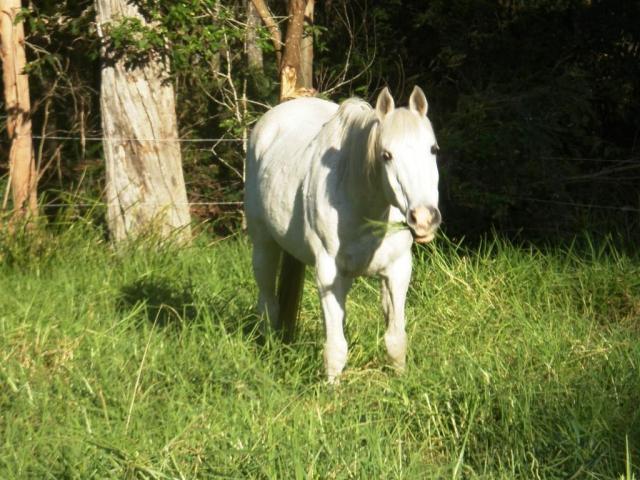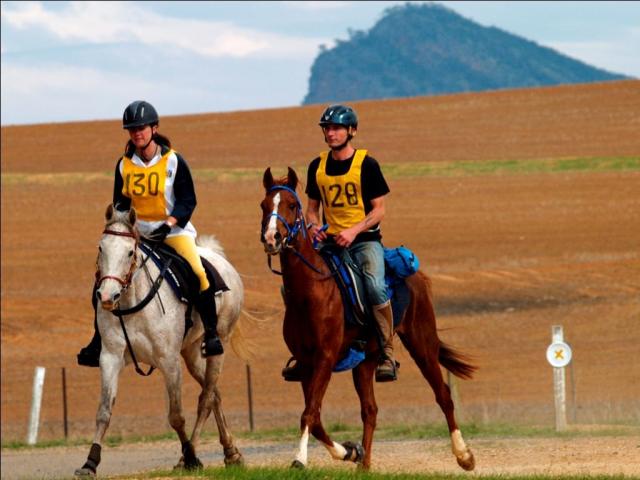Any discussion about your endurance horse’s diet must include discussion on fat : fat is so important in the energetics of sustained exercise. But before we begin, lets cover some terms:
Adipose fat is what we commonly think of as ‘fat’; fat storage depots around the body. Think ‘love handles’ and you get the idea.
Intramuscular Triglycerides (IMTGs) are specialised fats stored in-between muscle fibers and are an important source of fuel for sustained exercise.
Essential Fatty Acids (EFAs) are fats that must be supplied in the diet. These include your Omega3s and Omega6s. Simply put, Omega3s are involved in anti-inflammatory responses and Omega6s are involved in inflammatory responses but both are required by your horse’s body for many metabolic processes.
Volatile Fatty Acids (VFAs) result when microbes in the hindgut breakdown fiber. The VFAs are then absorbed by your horse’s digestive system for use. The most important VFAs are acetate, butyrate and propionate.
1. Acetate is easily converted to acetyl-CoA and used directly as an energy source by muscle for aerobic exercise. Excess is converted by the liver to fat.
2. Butyrate is mostly used as energy source by the cells lining the digestive tract but excess can also be converted by the liver to fat.
3. Propionate is either converted by the liver to glucose and then transported to muscle for use or storage as glycogen or it is converted by the liver to amino-acids and/or fat. Estimates suggest as much as 50% of blood glucose is derived from propionate.
So you can see, we need to take VFAs seriously.
Free Fatty Acids (FFAs) come from the breakdown of fat, either long-chain dietary fat in the digestive system or adipose fat from body stores, and are moved by the circulatory system to muscle, where they can be used as fuel for aerobic exercise.
The Good
Horses don’t eat, or need, much fat. The evolved diet (grasses, forbes, shrubs) was low in fat, no more than 5% of total calories. This explains why horses don’t have gall bladders: instead a continuous but very small amount of bile, important for fat digestion, trickles in to the small intestine.

Green pasture fulfils your horse’s total dietary requirement for fat, including the EFAs Omega3 and Omega6. Anything in the evolved diet that was rare and essential is processed very efficiently by the digestive system, including EFAs (as are sugars/starches and sodium, which were also rare in the environments where horses evolved). Green grass has a Omega3:Omega6 ratio of 4:1 or higher .That is, green grass is very high in anti-inflammatory Omega3 – which is one of the reasons why ‘poorly’ horses are turned out for a dose of Dr. Green.
Your horse on 24 hour pasture is getting around 16grams of Omega3 and 4 grams of Omega 6 each day. EFAs are lost when drying grasses into hay- about half the overall fat is lost but almost all Omega3 is lost – and need to be supplemented to meet dietary requirements. The easiest way replace lost EFAs is to add a 100g of ground flaxseed/linseed (grind seeds in a coffee grinder immediately prior to feeding) or 30mls of cold-pressed flaxseed/linseed oil to the daily ration (See Carol Layton’s article for more information on the various aspects of feeding linseed).
Fat is calorie dense. This is mainly because fat, unlike other energy substrates, is hydrophobic: no water is stored with it. If you could pull from your horse a kilo each of fat and glycogen (remember, glycogen is stored carbohydrate, as discussed in Carbs: The Good, The Bad And The Ugly), the fat has more than six times the amount of stored energy.
The Bad
Calories excess to needs get stored away. When the excess calories arrive as carbohydrates, for example, as sugars in spring pasture, first they are stored as glycogen in the muscles and liver and then, when the glycogen storage limit is reached, they are converted and stored as fat (IMTGs and adipose fat). Excess calories from dietary fat can only be stored as fat, first IMTGs are replenished then the rest stored as adipose fat. However, if you provide the same amount of excess calories from a carbohydrate source or from a fat source, the fat source will yield higher body fat because the conversion process for fat sources only uses up 3% of the calories where the conversion process for carbohydrate sources uses up nearly 25% of the calories. Feeding your horse fat makes him fat!
For this reason, some additional fat supplementation might be useful but only in VERY HARD WORKING endurance horses where fiber and grain can not provide sufficient calories. Generally, all horses require up to 5% of their total daily calories provided by fat (easily met by horses on green pastures) and this can be boosted to up to 8% for very hard working horses (NB, very few horses actually work hard enough that energy requirements can not be met by fiber and grain).
Do not feed fat at levels higher than 10% of total calories. Remember, structural carbohydrates, what we commonly call fiber, in pasture and hay are fermented by microbes in your horse’s hindgut into VFAs; an important, natural source of fat. With high-fat diets, excess fat that is not able to be absorbed by the small intestine leaks into the large intestine and disrupts this microbial fermentation, reducing the VFAs produced.

Rachel Reid on Shar and me on Ginge at about 120km into the 2007 Cob and Co 160km ride to take equal first in 10: 33 with Ginge awarded Best Conditioned. As an experiment, following a conversation with Jim Autio (who wrote The Digital Mantrap, one of the most interesting books I have read on human nutrition and exercise physiology) and who suggested that with dietary manipulation VFAs might be able to supply 40% or more of equine energy needs, Ginge was fed only fiber (pasture, hay, beet pulp) in the week up to and during the actual ride – no grain, no fat. His glycogen stores ran out at about 130km into the ride, after which our paced slowed significantly, down from an average of 16km/hr (10m/hr) to just over 12.5km/hr (7m/hr) from there. Still, in my books, that is a pretty good effort for a simple gutful of fiber – be sure to look after those microbes!
The Ugly
Remember, it is carbohydrate, stored as glycogen in muscles and the liver, that, energetically speaking, limits performance. This is true for both high-intensity speed-work and for lower-intensity endurance-work. Fat, as an energy source, is NEVER in short supply. For riders of performance horses the main problem with feeding diets high in fat is fat’s effect on carbohydrate uptake and utilisation. Muscle glycogen stores in working horses fed high-fat diets have been shown to be only 1/3 to 1/2 that of horses on low-fat diets.
There are countless studies concerning working horses adapted to high-fat diets and they universally demonstrate that these horses perform like unconditioned horses when compared to their low-fat diet counterparts. This is because a high-fat diet induces metabolic changes that compromise the entire process of carbohydrate utilisation, from digestion to muscle use. We know that glycogen availability is the energetic limiter of performance, including the sustained performance of endurance horse. Don’t confuse glycogen compromise with ‘glycogen sparing’ (as some equine feed manufacturers euphemise).
The simple way to ensure your endurance horse spares glycogen, by instead utilising those energy-rich IMTGs, is to work him. Because glycogen is the limiting energy substrate, exercising your horse, whether with speed work or with endurance conditioning, has the basic response of maximising the efficiency of glycogen fuel use. For endurance exercise, this means increased utilisation of and reliance onIMTGs and at increasing levels of work intensity. Then make sure you feed the work by providing adequate calories. To ensure that both glycogen and IMTGs stores are replenished, first ensure your horse is receiving sufficient fiber, both for gut health and to provide the raw material for VFAs. Remember, some VFAs are converted to glucose and can be used to replenish glycogen stores, others are converted to and replenish fat stores. If more calories are required, as they likely will be for any hard-working endurance horse, add grain safely (as described in Carbs: The Good, The Bad And The Ugly) – your horse can easily convert excess carbohydrate to fat once glycogen stores are replenished. The only dietary fat you need be concerned with is replenishing those EFAs if your horse lacks access to sufficient pasture.
More Info
Everyone interested in managing/riding performance horses should undertake Eleanor Kellon’s courses: NRC Plus and Nutrition For The Performance Horse.




